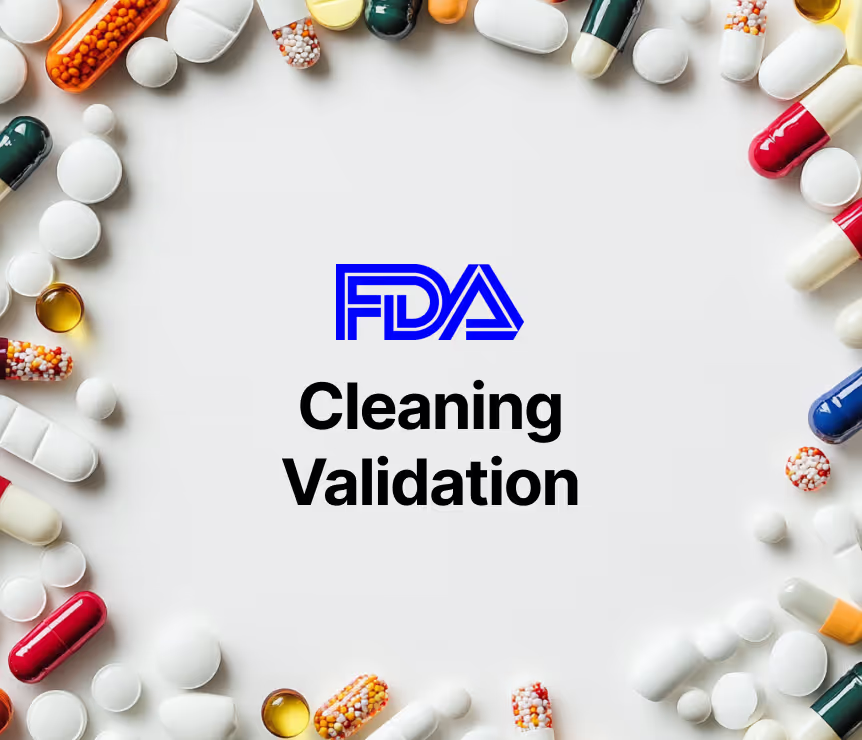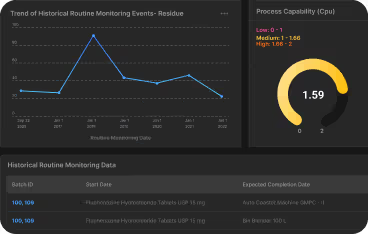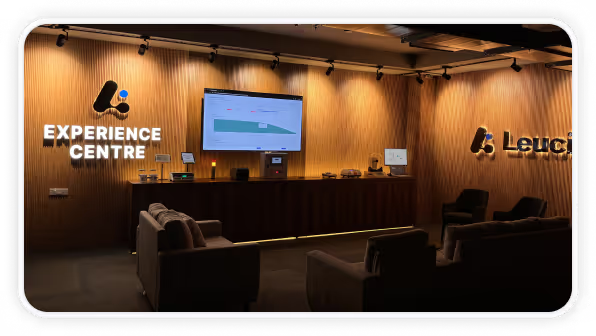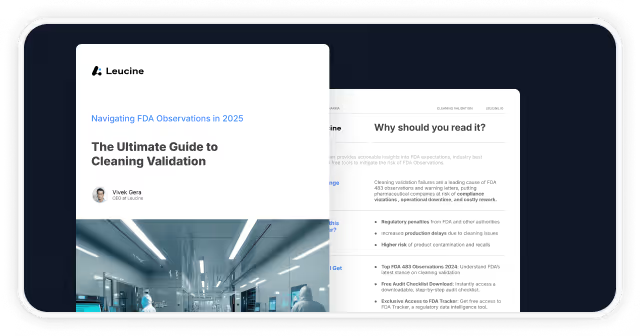MACO Calculation in Cleaning Validation: A Complete Guide

In pharmaceutical manufacturing, cross contamination of the active pharmaceutical ingredient poses a major risk to patient safety, product quality, and regulatory compliance. That’s why MACO (Maximum Allowable Carryover) is central to every cleaning validation strategy.
MACO defines the maximum allowable residue from a previous product that can remain on shared manufacturing equipment without compromising subsequent products. It sets a scientifically justified acceptance criteria—protecting product integrity, ensuring compliance with good manufacturing practices, and supporting regulatory requirements.
Whether you’re preparing for a process validation review, scaling in a pilot plant, or establishing new validation limits, understanding how to calculate MACO correctly is essential.
Why MACO Maximum Allowable Carryover Matters
Effective cleaning validation limits do more than meet a checklist—they ensure:

- Patient safety: No carryover of harmful active pharmaceutical ingredients or allergens.
- Product quality: The next batch is free from contamination, protecting therapeutic efficacy and stability.
- Regulatory alignment: Complies with frameworks from FDA, EMA, and global regulatory authorities.
The maximum allowable carry (MACO) is crucial for setting cleaning validation limits, ensuring that drug residues do not exceed safe levels in subsequent products.
New to cleaning validation? Start with the basics →
How to Calculate MACO: Health-Based vs. Dose-Based Criteria
In the pharma industry, calculating MACO is a critical step in establishing robust cleaning validation limits. This value represents the maximum allowable residue from a previous product that can remain on equipment before manufacturing the next batch—without risking patient safety or product integrity.
There are two primary approaches to determine MACO values, each based on different scientific and regulatory principles:

1. Dose-Based MACO Calculation (Traditional Method)
This method uses the therapeutic daily dose of the previous product, the maximum daily dose of the next product, and a conservative safety factor to determine acceptable residue.
Formula (Calculation Based on Dose):
.avif)
Key Inputs:
- Minimum therapeutic dose of the previous product
- Batch size of the next batch
- Maximum daily dose of the subsequent product
- Safety factor based on dosage form and route of administration (e.g., 1/1000 for oral, higher for injectables)
Dose-based criteria work best when data is available, but may not be sufficient for highly potent or toxic drug substances.
2. Health-Based MACO Calculation (Toxicological Approach)
This modern method is based on health-based exposure limits, such as:
- Acceptable Daily Exposure (ADE)
- Permitted Daily Exposure (PDE)
- No Observed Effect Level (NOEL), expressed in mg, is derived from the Lethal Dose 50 (LD50), represented in mg/kg, to determine safe levels of drug residues that can be allowed during cleaning procedures.
- Lethal Dose (LD50) in cases of limited data
Formula (Calculated Based on Toxicology):
.avif)
This approach is preferred by regulatory agencies—especially for highly potent APIs, injectables, and cases where minimum batch size or intended use pose higher risk.
Need help converting ADE to actionable cleaning limits? Explore this guide →

Dose-Based vs. Health-Based MACO
Best practice: Use health-based MACO limits for products with limited dosing data, injectable forms, or complex risk ratings.
Regulatory Requirements for MACO Calculation in Cleaning Validation
Determining the MACO value isn’t just a technical task—it’s a regulatory requirement. Whether you’re operating in the U.S., EU, or globally, regulatory agencies now expect scientifically justified, health-based cleaning validation limits rather than outdated fixed thresholds like 10 ppm. The pharmaceutical industries play a crucial role in ensuring compliance with these regulatory requirements by leveraging their expertise and rigorous standards.
Here’s how major agencies define the regulatory framework around maximum allowable carryover and cleaning validation:

FDA – U.S. Food and Drug Administration
The FDA emphasizes a risk-based approach and requires MACO to be calculated using toxicological data when appropriate.
Key Regulatory References:
- 21 CFR Part 211.67 – Prevents cross contamination through validated cleaning procedures.
- Process validation must include MACO limits backed by data analysis and documented risk assessments.
- Encourages use of health-based exposure limits (ADE/PDE) over arbitrary thresholds.
Takeaway:
FDA expects MACO to be calculated based on scientific principles and verified using validated sampling methods and analytical methods—not visual criteria alone.
Review top FDA observations in cleaning validation →
EMA – European Medicines Agency
EMA takes a stricter stance, especially for shared equipment used in pharmaceutical manufacturing of highly potent or toxic drug substances.
Key Regulatory Documents:
- EMA Guideline on Shared Facilities – Recommends health-based limits (ADE/PDE) instead of fixed limits like 0.1% or 10 ppm.
- EU GMP Annex 15 – Requires scientifically sound validation studies to justify MACO maximum allowable values.
- Annex 1 (2023) – Aligns cleaning validation with the overall contamination control strategy.
Takeaway:
Acceptance criteria must be derived from permitted daily exposure and toxicological risk—not solely from visual cleanliness or legacy dosing criteria.
ICH (International Council for Harmonisation)
ICH provides the foundation for cleaning validation as part of a broader quality risk management system.
Applicable Guidelines:
- ICH Q7 – Requires validated cleaning for drug substances (APIs).
- ICH Q9 – Promotes risk-based approaches in establishing cleaning validation limits.
- ICH Q10 – Links MACO to continuous improvement and lifecycle-based validation limits.
Takeaway:
ICH guidance encourages use of historical data, toxicological evaluation, and risk-based validation strategies—all aligned with itended use, dosage form, and body weight where applicable.
Evolving Expectations: 2023–2025 Trends
Compliance Tip: Align your MACO documentation with acceptable daily intake, safety factors, and risk ratings—and ensure full traceability of your validation studies.
Step-by-Step Example: How to Calculate MACO Using Dose-Based and Health-Based Limits
Understanding the theory is important, but being able to calculate MACO accurately in real-world scenarios is what makes your cleaning validation program inspection-ready. The final report includes details on formulas used, raw data, and equipment selected, ensuring a comprehensive overview that supports audit inquiries and decision-making processes.
Here’s a step-by-step walkthrough of two common approaches used to determine validation limits for maximum allowable carryover.
Scenario:
You’ve completed manufacturing Product A and are preparing to produce Product B using the same equipment. Your task is to ensure no residue from the previous product carries over and affects the next batch.
Example 1: Dose-Based MACO Calculation
This traditional method uses the minimum therapeutic dose, maximum daily dose, batch size, and a safety factor to define the MACO value.
Formula:
.avif)
Input Data:
- Minimum therapeutic dose of Product A: 10 mg
- Maximum daily dose of Product B: 1000 mg
- Batch size of Product B: 500 kg (500,000,000 mg)
- Safety factor: 1/1000
Calculation:
.avif)
Result:
A maximum allowable carryover of 5 g is acceptable from Product A into the next batch of Product B.
This value is then converted into an actionable swab limit, such as:
- mg/swab (based on swabbed area)
- mg/cm² (based on equipment surface area)
- ppm in rinse sampling
Example 2: Health-Based MACO Calculation Using ADE
This method applies health based exposure limits, such as Acceptable Daily Exposure (ADE), and is preferred when dealing with potent APIs, cytotoxic drug substances, or limited data on dosing.
Formula:
.avif)
Input Data:
- ADE of Product A: 0.5 mg/day
- Batch size of Product B: 500 kg (500,000,000 mg)
- Max daily dose of Product B: 1000 mg
Calculation:
.avif)
Result:
The calculated MACO value is 250 g—but you may need to apply an adjusted safety factor or reference a marker compound if the product is injectable or particularly hazardous.
Best Practice: Convert MACO to Actionable Acceptance Criteria
Whether your MACO is dose-based or health-based, it must be applied using real-world test methods:
Want to improve your sampling strategy? Explore swab and rinse validation best practices →
Best Practices & Common Mistakes in MACO Calculation for Cleaning Validation
Getting the MACO calculation right isn’t just about applying a formula—it's about understanding the broader cleaning process, aligning with regulatory requirements, and ensuring product quality across all operations.
Below are the top best practices followed by leading pharmaceutical manufacturers, along with the common errors that can trigger audit findings or compromise intended use.
Best Practices for Accurate MACO and Cleaning Validation Limits
1. Use Health-Based Exposure Limits Over Fixed Criteria
Outdated thresholds like 10 ppm or 0.1% of batch size are no longer sufficient. Modern regulatory frameworks favor health-based exposure limits (e.g., ADE, PDE) supported by toxicological data.
Establish MACO values based on acceptable daily exposure and use validated data wherever possible.
2. Validate Sampling Methods
It’s not enough to calculate—you need to prove your cleaning is effective.
Validation studies should include:
- Swab recovery ≥ 70% for APIs or cleaning agents
- Rinse method specificity and sensitivity
- Clear definition of swab limit or marker compound criteria
- Replicable sampling methods across surfaces and equipment types
3. Avoid Manual Spreadsheets
Spreadsheet software is prone to:
- Version control issues
- Calculation errors
- Broken formulas
- Limited traceability
Switching to structured tools improves accuracy, auditability, and alignment with good manufacturing practices.
4. Apply Route-Specific Safety Factors
Safety factors should reflect dosage form, body weight, and risk level:
Don’t apply a one-size-fits-all SF across all drugs—especially for highly potent or injectable drug substances.
5. Document Everything—And Keep It Current
Every MACO value must be backed by:
- Documented rationale and data analysis
- Calculations based on therapeutic dose or permitted daily exposure
- Mapping of equipment surface areas
- Links to related validation studies and regulatory requirements
Want to stay current with upcoming 2025 guidelines? Read the cleaning validation trends forecast →
Common Mistakes That Compromise Compliance
1. Relying on Visual Criteria Alone
Visual cleanliness is not an acceptable MACO acceptance criterion on its own, even though equipment must be visually clean with no visible residue after cleaning. Regulators now expect analytical method validation to confirm residue removal.
2. Reusing Generic Safety Factors
Applying SF 1000 across all products—regardless of intended use or dosage form—underestimates risk and may lead to citations.
3. Ignoring Worst-Case Product Scenarios
Failing to use more data or worst-case product pairs (most potent × lowest batch size × injectable form) weakens your validation rationale.
4. Using Outdated or Limited Data
Calculations based on normal therapeutic dose without toxicology or limited data can leave you exposed during audits.
5. Poor Sampling Technique
Low-recovery swabs, inconsistent areas, or untrained staff lead to unreliable results—jeopardizing product integrity and regulatory alignment.
Key Takeaway:
Strong MACO programs go beyond calculations—they combine validated sampling methods, updated toxicological data, and a risk-based understanding of how cleaning affects subsequent products and patient safety.
Analytical Methods to Verify MACO in Cleaning Validation
Calculating the MACO value is only half the process. Regulatory authorities expect manufacturers to verify cleaning validation limits with precise, scientifically sound analytical methods—especially when dealing with active pharmaceutical ingredients (APIs) or highly potent drug substances.
These methods must demonstrate that the cleaning process removes residues from the previous product below the swab limit or rinse threshold defined by your MACO calculation.
1. Swab Sampling – Surface-Specific and Targeted
Swab sampling is the most widely used sampling method for verifying equipment cleanliness, especially in worst-case areas like corners, gaskets, and dead legs.
Best For:
- Manual cleaning validation
- High-risk contact surfaces
- Poorly soluble cleaning agents or APIs
Key Highlights:
- Standard area: 25 cm²
- Results measured as mg/swab or mg/cm²
- Swabs made from non-reactive materials (polyester, nylon)
Validation Tip:
Perform recovery studies to confirm that the method retrieves at least 70% of spiked residue. These validation studies must reflect real equipment surfaces and product characteristics. Use a marker compound if the previous product is no longer available or hard to detect.
2. Rinse Sampling – Ideal for Complex Equipment
Rinse sampling analyzes residual content in cleaning solution used during the final rinse cycle.
Best For:
- CIP systems, tanks, and hard-to-swab pipes
- Water-soluble residues
- Broad equipment coverage
Key Highlights:
- Results reported as ppm or µg/mL
- Rinse volumes range from 250 mL to 1 L
- Faster turnaround than swabbing for some systems
Validation Tip:
Match your rinse volume and sampling protocol to the actual cleaning process, not lab-scale setups. Combine with historical data to refine thresholds for acceptable daily exposure.
3. HPLC – The Analytical Gold Standard
High-Performance Liquid Chromatography (HPLC) is the preferred analytical method for detecting trace levels of active pharmaceutical ingredients.
Best For:
- Highly potent substances
- Products with low MACO limits
- Validation of swab or rinse sample content
Key Highlights:
- Highly specific and accurate
- Detectors: UV, MS, ELSD depending on compound
- Paired with method validation per ICH Q2 guidelines
4. Total Organic Carbon (TOC) – Quick, Non-Specific Screening
TOC testing measures all organic carbon content, making it useful for detecting residues when chemical specificity isn’t required.
Best For:
- Screening multiple cleaning validation points
- Monitoring for excipients or cleaning agents
Key Highlights:
- Expressed in ppm
- Fast analysis
- Must correlate TOC to known API or excipient carbon content
Limitation:
TOC cannot distinguish between previous product, cleaning agent, or other organic material—best used alongside other analytical methods.
What Validation Studies Must Include
To satisfy regulatory authorities, all methods used to verify MACO must be validated with:
These validation studies ensure that MACO limits are not only calculated—but confirmed under real operating conditions.
Key Takeaway:
A MACO calculation without a validated analytical method is just a number. Regulators want to see proof—collected, quantified, and documented.
See how automated MACO calculations elevate your cleaning validation—download the white paper today.
Digital Tools and Automation in MACO Calculation
In today’s pharmaceutical industry, managing MACO calculations, validation studies, and cleaning documentation manually—often through spreadsheet software—is increasingly risky.
With rising product complexity, limited data availability, and ever-evolving regulatory requirements, companies need more reliable, scalable, and compliant ways to manage cleaning validation processes.
The Limitations of Spreadsheet-Based MACO
While spreadsheet tools may seem convenient, they introduce major issues:
- Hidden formula errors that affect MACO values
- Lack of audit trails and version control
- Inability to adapt to new toxicological data or daily exposure limits
- Disconnection from cleaning protocols and risk assessments
MACO must be calculated based on the most current data. Static tools can’t keep up with changes to product specs, batch size, or cleaning validation limits.
Why Automation Improves MACO Compliance
1. Consistent, Repeatable Calculations
Digital systems ensure that MACO values are applied consistently across all product pairs, dosage forms, and equipment—regardless of who inputs the data.
2. Integrated Risk Factor Logic
Automation platforms can embed logic that adjusts MACO based on:
- Dosage form
- Body weight assumptions
- Permitted daily exposure
- Route-specific safety factors
3. Real-Time Updates Based on More Data
When ADE, PDE, or cleaning agent profiles are updated, MACO calculations can auto-adjust—avoiding reliance on limited data or outdated assumptions.
4. Automated Documentation & Traceability
All MACO-related decisions, adjustments, and results are logged automatically—streamlining audit readiness and enabling data analysis across cleaning cycles.
Digital MACO Management Across the Validation Lifecycle
Modern digital tools support full lifecycle tracking of MACO-related activities:
Bonus: Digital MACO platforms often integrate with cleaning validation modules, batch records, and even historical data analysis tools—bringing greater visibility and control.
Key Takeaway:
Manual MACO management can slow down compliance, increase risk, and limit the ability to scale across multiple cleaning processes.
By adopting automated, rule-driven tools, pharma teams gain:
- Real-time adaptability
- Smarter risk-based cleaning protocols
- Confidence during inspections
Risk-Based Approaches in MACO: Aligning Limits with Product Risk
Modern cleaning validation is shifting away from one-size-fits-all formulas. Today’s regulatory authorities expect MACO values to be set using risk-based thinking—tailored to product potency, intended use, dosage form, and toxicological data.
A strong risk-based approach ensures that cleaning validation limits are scientifically justified, scalable, and focused on protecting patient safety.
Step 1: Identify Critical Risk Factors
Not all pharmaceutical products pose the same risk. Before you calculate MACO, evaluate these key risk factors:
The more potent and harder to clean, the lower your MACO value must be.
Step 2: Choose the Right MACO Method Based on Risk
Use a tiered approach based on product risk and available data:
If minimum batch size or high daily exposure amplifies patient risk, opt for more conservative methods.
Step 3: Evaluate Worst-Case Product Combinations
For efficient and defensible validation, assess your worst-case cleaning scenario:
- Most potent previous product
- Smallest batch size for next product
- Most sensitive dosage form (e.g., injectable)
Validating cleaning procedures under this scenario allows broader applicability across other product pairs.
Step 4: Apply Justified Safety Factors
Safety factors should reflect both scientific rationale and process validation outcomes. Don’t default to generic SF values.
Regulatory inspectors often cite teams that apply SF 1000 across all routes without proper justification.
Step 5: Document the Risk Assessment
For every MACO decision, your validation studies and cleaning SOPs should clearly document:
- Risk scoring of products and equipment
- Basis for MACO calculation (dose-based or toxicological
- Source of toxicological or historical data
- Justification for acceptance criteria and safety factors
- Link to your contamination control strategy
Regulatory Expectations (Global Snapshot)
Key Takeaway:
A risk-based MACO strategy strengthens your cleaning validation program by prioritizing effort where it matters most—ensuring compliance, reducing rework, and protecting product quality and patient safety.
Trends and Innovations in MACO: The Future of Cleaning Validation
As pharmaceutical manufacturing advances, so do expectations for precision, efficiency, and compliance in cleaning validation. The traditional ways of setting validation limits and verifying cleanliness are evolving—driven by digital transformation, risk-based thinking, and smarter data use.
Here’s a look at the innovations shaping how teams calculate and manage MACO limits today—and what’s coming next.
1. AI and Predictive Models for MACO
Emerging tools use data analysis and historical data to predict contamination risks, optimize safety factors, and recommend MACO values dynamically. These systems can:
- Evaluate previous trends in daily exposure and failure rates
- Predict cleaning failures based on equipment usage, cleaning agents, and dosage form
- Adjust MACO automatically when more toxicological data becomes available
Especially useful for highly potent products where traditional calculation approaches may be too limited.
2. Automated MACO Recalculation When Data Changes
In a dynamic production environment, more data is always emerging—from stability studies to updated acceptable daily exposure values. New digital systems can:
- Auto-update MACO calculations when ADE, PDE, or LD50 values are revised
- Log when and why changes occurred
- Prevent outdated or non-compliant acceptance criteria from affecting subsequent products
3. Real-Time Residue Monitoring
Instead of waiting for end-of-cleaning validation results, companies are starting to deploy in-line sensors to track cleanliness continuously. These systems detect:
- TOC (Total Organic Carbon)
- Conductivity
- Cleaning agent residues
- Swab sampling anomalies across pilot plant or full-scale operations
Real-time monitoring enhances product quality by identifying contamination risk before the next batch is produced.
4. Digital Cleaning Validation Platforms
Modern platforms allow teams to manage the entire cleaning validation lifecycle, including:
- Assigning MACO and validation limits per product
- Tracking batch size and therapeutic dose pairings
- Managing sampling methods and cleaning SOPs
- Linking MACO data to process validation and stability study outcomes
Centralized systems reduce errors and streamline audit preparation—especially valuable in multi-product facilities.
5. Sustainability & Smart Cleaning Efficiency
MACO innovation isn’t just about compliance—it’s also about smarter resource use:
- AI can help avoid over-cleaning (saving water and energy)
- Predictive tools prevent under-cleaning (protecting product integrity)
- Cleaning cycles are based on intended use, residue risk, and cleaning performance—not static schedules
Supports both regulatory compliance and environmental goals.
Final Takeaway:
The future of MACO in cleaning validation is smarter, faster, and more connected. Teams that embrace these innovations can reduce compliance risk, protect patients, and accelerate production cycles—without sacrificing data integrity or product quality.
Automate MACO, validate faster—Leucine’s CLEEN simplifies calculations and ensures audit-ready cleaning processes.
Frequently Asked Questions





















